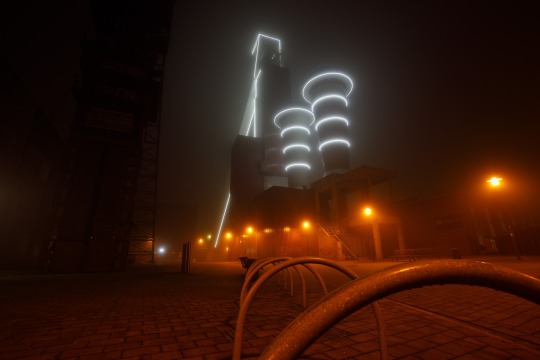#Gunda Förster
Explore tagged Tumblr posts
Text
WeeklyPic - Wochenbild 03/2022
WeeklyPic – Wochenbild 03/2022

View On WordPress
#Adobe#Beleuchtung#Canon#Gunda Förster#herten#industriedenkmal#industriekunst#kunst#Licht#Lightroom#Nacht#schlägel&Eisen#weeklypic#zeche#Zeche Schlägel&Eisen
0 notes
Photo

4 + 20 Lichtstunden https://kunst.celle.de/Ausstellungen/ 10. Dezember 2021 bis 20. März 2022 Über vierzig Positionen und fast 100 Werke internationaler Lichtkunst: Eine der größten öffentlich zugänglichen Sammlungen dieser Art lässt das Kunstmuseum Celle weit über die Grenzen der Stadt nach außen strahlen. Lichtkunst zeigt, was Licht sein und bedeuten kann: Zeitmesser, Kommunikationsinstrument, magischer Verwandler, Blendwerk und nicht zuletzt die schnellste Welle im Universum. Die Auswahl von 4+20 Künstlern, Künstlerinnen und Künstlergruppen für den tagaktiven Teil der Ausstellung verweist auf das ungewöhnliche Museumskonzept des Hauses: Als das „erste 24-Stunden-Kunstmuseum der Welt“ ermöglicht es rund um die Uhr Begegnungen mit Kunst. Vier bekannte Highlights sind die Trägerinnen und Träger des Deutschen Lichtkunstpreises der Robert Simon Kunststiftung – Otto Piene, Mischa Kuball, Brigitte Kowanz und Jan Van Munster. Sie machen Appetit auf mehr: mehr Licht, mehr Kunst und mehr Entdeckungen. Zu jeder Lichtstunde leuchtet es anders, am Tag und bei Nacht, innen und außen – und sogar am Lichtkunstbahnhof Celle. Im Kunstmuseum | am Tag TIM BERRESHEIM | WALTRAUD COOPER | PHILIPP GEIST | KLAUS GELDMACHER | HARTUNG TRENZ | DANIEL HAUSIG CHRISTIAN HERDEG | MARGARETA HESSE | ALBERT HIEN | CHRISTOPH HILDEBRAND | STEFAN HUBER | KAZUO KATASE BRIGITTE KOWANZ | SIEGFRIED KREITNER | MISCHA KUBALL MADER WIERMANN | CHRIS NÄGELE | OTTO PIENE BORIS PETROVSKY | PATRICK RAYNA UD | T HOMAS REUL STEPHAN REUSSE | PAUL SCHWER | JAN VAN MUNSTER Lichtkunstparcours | bei Nacht BORIS PETROVSKY | OTTO PIENE | TIMM ULRICHS ALBERT HIEN | VOLLRAD KUTSCHER | HA RTUNG TRENZ FRANCESCO MARIOTTI | VOLLRAD KUTSCHER SIEGFRIED KREITNER Lichtkunstbahnhof Celle WALTRAUD COOPER | GUNDA FÖRSTER | PHILIPP GEIST ALBERT HIEN | HARTUNG TRENZ | HANS KOTTER VOLLRAD KUTSCHER | TIMM ULRICHS (hier: Kunstmuseum Celle mit Sammlung Robert Simon) https://www.instagram.com/p/CXhJcbbI9dI/?utm_medium=tumblr
0 notes
Text
Gunda Förster (1967)
For the next three blogs i have chosen lesser known artist, but i think they are still important. The first is Gunda Förster.
Gunda Forster and Francois Morellet were presented in one exhibition at the Bundestag in Germany. A just decission since both are very much related to eachother. Where Morellet presented his figurative works ,Gunda Förster presented her Konkret ones.
View On WordPress
0 notes
Text
references
Gunda Förster
Circle
https://vimeo.com/51449609
“Gunda Förster (1967, Berlin) studied at the Hochschule der Künste, Berlin. She has received numerous awards and grants, including the 1st German Art Prize; a DAAD grant for study in the U.S.; the Karl Schmidt-Rottluff grant; the 2003 H. W. & J. Hector Art Prize, Mannheim. Exhibitions in Germany and worldwide. She was guest professor at Leibniz University, Hannover and Professor of Art at the University of Applied Science, Wismar. She is the frst recipient of the H. W. & J. Hector Art Prize awarded by the Kunsthalle Mannheim. She lives and works in Berlin. “
Carsten Höller
Neon Circle
“German artist Carsten Höller focuses mainly upon the production of installation art and regularly invites the participation of the viewer. This interaction between the viewer and the object is an attempt by Höller to provide relief from what he calls the burden of straightforwardness. Höller finds himself drawn towards making work that crosses the boundaries between fine art, science and sociology.
Höller was commissioned by BALTIC to make work for the opening exhibition in July 2002. He created an installation which included two light sculptures, Baltic Phi Wall, 2002 which was exhibited across the back wall, dominating the space within which Neon Circle, 2001 was also shown. Visitors were encouraged to enter Neon Circle, 2001. Both works use light to create a physically disorientating effect in the viewer, altering his or her perception of the space, stimulating visual phenomena.
Baltic Phi Wall, 2002 was designed around a concept discovered by Gestalt psychologist Max Wertheimer in 1912. If two dots are projected in rapid sequence next to one another, with a short moment of black in between, most observers ‘see’ an imaginary ball jumping from one to the other. This effect is remarkable, as it raises the question of how the viewer can ‘know’ where the second dot will be projected, when the imagined ball is already on its way towards the future site of projection. This is also possible with two projections of different colours; the viewer experiences a sudden shift in colour between the projection sites. The Baltic Phi Wall, 2002 is an extended display of this phenomenon. Four imaginary balls were seen ‘jumping’ simultaneously over a surface of 93 dots, thereby sometimes changing colour. The sequences were generated at random.”
http://balticplus.uk/carsten-holler-baltic-phi-wall-and-neon-circle-e287/
Sandra Araújo
RIO-ME PORQUE ÉS DA ALDEIA E VIESTE DE BURRO AO BAILE
“This video features popular songs and imagery combined with computer-based aesthetics. Visual elements feature iconic images, 8-bit, pixel and glitch. The sound is the result of sampling and mixing fado. Sandra Araújo is a visual artist who has spent endless hours shooting at monsters and strolling through mazes. So, it only felt natural for her to evolve her work toward exploring the visual culture of games and popular gif fles in her animations. “
https://vimeo.com/175414380
abstracts from: http://www.isea-archives.org/docs/2015/catalogue/ISEA2015_catalogue.pdf
0 notes